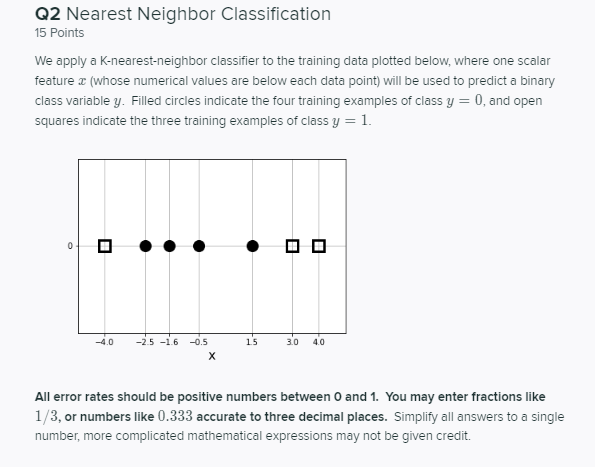

Q2 Nearest Neighbor Classification 15 Points We apply a K-nearest-neighbor classifier to the training data plotted below, where one scalar feature 2 (whose numerical values are below each data point) will be used to predict a binary class variable y. Filled circles indicate the four training examples of class y = 0, and open squares indicate the three training examples of class y = 1. . OO -4.0 -2.5 -1.6 15 3.0 4.0 -0.5 All error rates should be positive numbers between 0 and 1. You may enter fractions like 1/3, or numbers like 0.333 accurate to three decimal places. Simplify all answers to a single number, more complicated mathematical expressions may not be given credit. Q2.1 1-NN Error Rate 4 Points Compute the leave-one-out cross-validation error rate of a 1-nearest-neighbor classifier. Enter your answer here Q2.2 3-NN Error Rate 4 Points Compute the leave-one-out cross-validation error rate of a 3-nearest-neighbor classifier. Enter your answer here Q2.3 5-NN Error Rate 4 Points Compute the leave-one-out cross-validation error rate of a 5-nearest-neighbor classifier. Enter your answer here Q2.4 Choice of Neighborhood Size 3 Points Assuming you don't have access to additional data, how would choose the number of neighbors k based on the results of the previous parts? Clearly justify your answer in 1-2 sentences. Q2 Nearest Neighbor Classification 15 Points We apply a K-nearest-neighbor classifier to the training data plotted below, where one scalar feature 2 (whose numerical values are below each data point) will be used to predict a binary class variable y. Filled circles indicate the four training examples of class y = 0, and open squares indicate the three training examples of class y = 1. . OO -4.0 -2.5 -1.6 15 3.0 4.0 -0.5 All error rates should be positive numbers between 0 and 1. You may enter fractions like 1/3, or numbers like 0.333 accurate to three decimal places. Simplify all answers to a single number, more complicated mathematical expressions may not be given credit. Q2.1 1-NN Error Rate 4 Points Compute the leave-one-out cross-validation error rate of a 1-nearest-neighbor classifier. Enter your answer here Q2.2 3-NN Error Rate 4 Points Compute the leave-one-out cross-validation error rate of a 3-nearest-neighbor classifier. Enter your answer here Q2.3 5-NN Error Rate 4 Points Compute the leave-one-out cross-validation error rate of a 5-nearest-neighbor classifier. Enter your answer here Q2.4 Choice of Neighborhood Size 3 Points Assuming you don't have access to additional data, how would choose the number of neighbors k based on the results of the previous parts? Clearly justify your answer in 1-2 sentences








